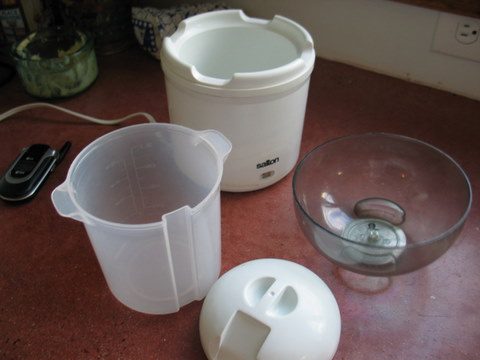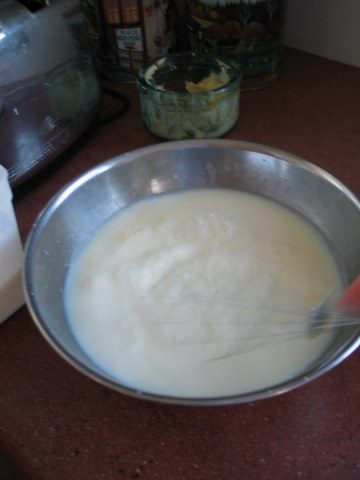I taught myself how to make yogurt about ten years ago when Mr. Handsome and I were living in Nicaragua. There the cows were so skinny that there was no cream in the milk, but I was still able, somehow to make thick, creamy yogurt (quite possibly it was because of the lack of sanitation and consequently the abundance of bacteria). Incubating the milk was a cinch—just four hours in a thermos.
When we came back to the States, I had to refigure everything. The milk was pasturized and the little cups of yogurt that I bought from the store to use as starter didn’t seem to have the same kick. A thermos didn’t work anymore, either, for whatever reason.
I finally bought a yogurt maker, a Salton.

I experimented with different plain yogurts and discovered that Dannon’s plain yogurt worked well. The resulting yogurt was runnier then what we had in Nicaragua, but it would do.
For the past several years we have been buying raw milk from a farm

and the yogurt is thicker—bacteria is good, you know.
Mama JJ’s Yogurt
If you are buying your milk from a store, make sure it is not ultra-pasteurized. Also, the more local the milk is, the better it works; I haven’t had much luck with the generic store-brand milk. I prefer 2 % milk, or even whole, but skim will work fine, too. If you are using raw milk, just partially skim it.
Powdered yogurt starter can be bought from a number of places, including the Lehman’s catalog and New England Cheesemaking Supply Company, but I think the store-bought plain yogurts, like Dannon and Stoneyfield, are good enough. The key is to use the less-processed yogurts, the ones that don’t have all the blessed bacteria zapped out of them. In subsequent batches, you can just use your own yogurt as starter for the next batch. Once your yogurt is established, you only need about 1/4 cup of yogurt to start a new batch. You don’t need to get a new starter unless your yogurt becomes contaminated and starts to taste funny—I haven’t used a new starter in a long, long time, maybe a year.
4 cups milk
½ cup plain yogurt
1. Pour four cups of milk into a saucepan. Heat it on medium high heat until it’s steaming and a skim has formed on top. Do not let it boil. (If it does, don’t worry. It should still work. You just don’t want to make a habit of it, mostly because it makes a horrific mess and you won’t want to do a deep clean of your stove every time you make yogurt.)

2. Pour the hot milk into a bowl to cool.

3. Plug your yogurt maker in so that it can warm up.

4. When the milk has cooled to lukewarm (I just test it with my finger, but if you’re using a thermometer, the milk should be about 110-120 degrees, though I have heard that it can be as high as 130 degrees), add the starter yogurt and whisk vigorously.


5. Pour the mixture into the incubator and let it sit for 4-8 hours, or until firmly set (some yellowish whey may be floating around on top—that’s normal). The yogurt becomes more acidic the longer it is in the incubator, so you want to get it out as soon as it has set.

6. Put the container of yogurt directly into the fridge (not the whole incubator, of course, just the container which holds the yogurt) and let it set, undisturbed for 12 hours, or overnight. Before transferring it to a new container, gently pour off and discard any whey that has risen to the top.

When you are ready to eat it, scoop out what you need, plop it into a bowl, add your sweetener (jams, fruit sauces, honey, etc), and enjoy.

Don’t forget to save a quarter cup to start your next batch.
Note: Click here for a creamier yogurt.



12 Comments
Judy
Hello. Just made the yogurt starter using the peppers ( you tube) and now have a culture… yay!! Can I put this in the fridge until ready to use or should I just leave on the counter?
Just starting my journey down the cheese etc rabbit hole… whahoo!
Jennifer Jo
Yes, you can refrigerate it! Just treat it like any yogurt. Have fun falling down the cheese rabbit hole — it’s a deep one!
Jennifer Jo
I only buy a little container as the starter and then use my own yogurt as the starter for subsequent batches (I can use my own starter for months and months). The main reason I make my own is that it's cheaper and it cuts down on unnecessary waste—all those plastic containers. Plus, I think it's probably healthier—no added chemicals. And if you're using raw milk, it's a LOT healthier.
Anonymous
What is the benefit of making yogurt at home? I noticed you bought yogurt to make it so why not just continue to buy that? Is it cheaper in the long run? Is it healthier? Thanks.
Christy
i use a crockpot to incubate my yogurt. i turn it on low for 15 minutes before putting my yogurt in pint jars. then i turn it off, put the jars in, and wrap it in a big bath towel. I let it incubate for about 5 hours, then put the jars directly into the fridge to cool. one less kitchen gadget to deal with!
Jennifer Jo
Lynn, I'm not sure what you mean. Do you mean how high is too high to heat the milk prior to making yogurt? If so, my books say to heat the milk to 180 degrees and cool to 110 before adding the starter. Not sure that answers your question…
Cookie baker Lynn
Lovely! I've been buying raw milk, too. Do you know at what temperature the milk proteins change and become not friendly to the body?
Jennifer Jo
Cindy, I got my yogurt maker at the kitchen store at the Dayton Farmer’s Market. I suspect that whatever they have will be just fine. Or order another, similar one. Making yogurt is pretty popular nowadays—there’s probably a lot of stuff out there that’s much better than what I have. A middle of the road maker will cost about 20-25 dollars, I think. Good luck!
Anonymous
I’m having trouble locating the Salton model you mention as it’s out of production. Have any suggestions of where to get one? Have you ever tried the Yogotherm model sold on Ricki Carroll’s website? Cindy
current typist
My yogurt finally started getting thick (almost like the real stuff) when I boiled the milk for a while, as you suggested to me once. That was with regular store-brand milk. I’ve been letting it cool to between 100 and 110 on the thermometer; next time I’ll try it a little warmer. -ME
Anonymous
Have you tried making raw whole milk yogurt a la Sally Fallon’s recipe in Nourishing Traditions, where you heat the milk only to 110 degrees before adding culture? That’s what I’ve been doing for at least two years now, using my own culture and a 95 degree water bath. It is fabulous every time – thick, creamy and deliciously tangy.
Now the only trouble is that I’ve decided to cut down my dairy intake in order to clear up my congestion, which means I’m not eating yogurt every day any more!
Kris
Second Sister
I havent had time to make yogurt for a while, but I’d taken to making yogurt (and eating it almost 3x a day!!) for a while in the past couple years. I used a water bath in a cooler to incubate since I didnt have the yogurt machine thing. The thermometer was my key to making good yogurt. the only trick was keeping track of the little scrap of paper that I wrote the various temperatures down on;) I read somewhere that timing and temperature are factors in how sour and how thick the stuff gets. right now, I’m pleased when I get good thick congelation (word?).
I really like having a blog of your days to read about.seems like this modern method of techno communication kinda jives with the members of our families since we like to tell stories and read stories, eh? also we all like to talk/read about our gardens and our kids or nieces and nephews!